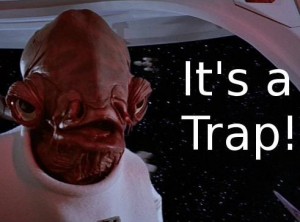We talk to a lot of brands about their journey to 1-to-1 personalization. They realize the potential but tend to bring up a number of barriers. Here’s how we help them leap over those barriers and accelerate their journey to 1-to-1 personalization that drives results.
Barrier #1: What to personalize?
Barrier:
In the world of basic segmentation, you break your various audiences into a handful of buckets according to their location, device type, or demographic profile. Then you use those segments to build single-channel experiences (like your website). But the world of 1-to-1 personalization is infinitely larger. There are thousands of potential options for every individual: content, product recommendations and promotions, not to mention where and when you should interact with them. Where to start?
Solution:
The leading 1-to-1 personalization platforms use machine learning to leverage real-time models to determine what experience works for which individuals. If you want to benefit from the differentiation 1-to-1 personalization offers, you need to move beyond the rules-based approaches that just don’t scale. We advise our clients to start with a business objective (i.e. maximize profit per session), and let machine-driven models choose the best tactics to achieve that goal, first on the web and then across the entire marketing ecosystem.
Barrier #2: Unorganized customer data
Barrier:
1-to-1 personalization needs one thing: actionable customer data. That means the data needs to be captured and consolidated. Perhaps you already have a good bit of identifiable data from loyalty programs, transaction histories, or online check-ins. But even if you do, it’s often disaggregated in an unusable format.
Solution:
1-to-1 personalization can utilize all of your customer data, and use those insights to power each and every decision. Using cookie-based identifiers, a platform can quickly begin to recognize anonymous events and associate them with your customers, no matter what device they happen to be using. Then you can add third-party data from your DMP (or any other provider), supplementing your real-time 360º view of every customer. Best of all, it’s all data that you own and control.
When you start small, machine learning can become even more effective as you add more data. This means that you can get immediate value from online personalization, without complex rules, with the data you have. Then you can scale it up from there.
Barrier #3: Organizational silos
Barrier:
The ways people shop is changing, and the ways brands keep up with them need to change, too. Fast. But the move from specialized departments to cross-functional teams takes time and the path forward isn’t always obvious. Maybe your ecommerce team only thinks about website optimization, while the acquisition side of the house is focused solely entirely on advertising display. This means these teams can’t work towards a unified data and technology effort that will make all of them, and the organization, more successful.
Solution:
The organizational approach to 1-to-1 personalization usually takes one of two forms. The top-down approach starts at the top of the company, ideally with the CEO or a C-level exec taking responsibility for personalization as a corporate initiative, with Board-level KPIs. Then, a senior leader within the organization is appointed as the personalization or omnichannel lead. It’s their job to bring all of the silos together around a unified personalization strategy.
Then there’s the bottom-up approach. It usually starts with a less senior team, spurred by a director or VP-level champion who sees the potential of personalization to help them further their immediate goal along with the outsized impact to the rest of the company. The bottom-up approach is more lean and typically identifies one specific use that can get done quickly and address an immediate business need. This is often a cross-channel initiative between two teams, such as ecommerce and storefront, who want to create an integrated solution. For example, the teams might integrate digital into the store experience, addressing both their goals of enhanced customer loyalty and revenue lift.
Barrier #4: Not enough content
Barrier:
If you want to deliver a personalized experience for each individual, you have to show everyone totally unique images and copy, right? But if that were the case, the creative department would never be able to keep up with the constant demand for new material.
Solution:
First, 1-to-1 personalization does NOT require unique content for every individual. You can get really far on a handful of creative elements that reflect the varied interests of your customers. What makes for a good 1-to-1 experience isn’t just the brand imagery, message, product recommendation, or promotions, but the combination of those elements, across a particular touchpoint (i.e. email vs. SMS vs. social messaging), at the right time for that individual.
Second, the future of personalization isn’t confined to automation around which experiences to serve up to which people, across which touch points, and at what time. It will also include elements of automated content creation. You may create automated content that auto-fills the first name of your customers. The not-so-distant future will involve platforms that bring all of this together to further automate the creative personalization process and drastically reduce the burden on all of us to keep up with the future demands of increasingly personalized algorithms.
Don’t make perfect the enemy of the good
You don’t need all your data integrated in a single system. You don’t need all the organizational incentives perfectly aligned. You don’t need hundreds of creative assets lined up and ready to go. The vast majority of brands have more than enough of all these things to get going on personalization projects and can start with one or two focused projects.
When brands attempt to build the technology and analytics infrastructures required for personalization in-house, most will fail. Why build it your own when there are technology platforms available that are 100% focused on some or all of the personalization stack? Given how fast this space changes, those platforms are the ones who are most likely to have the best-of-breed solutions that you can utilize at a fraction of the cost, with a higher success rate than doing it all on your own.
Digital & Social Articles on Business 2 Community(89)
Report Post



